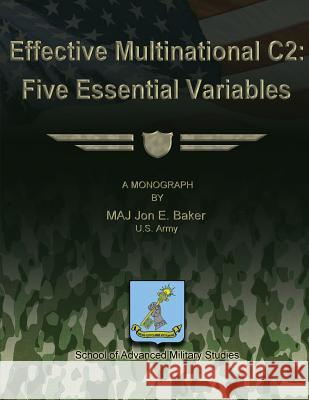Effective Multinational C2: Five Essential Variables » książka
Effective Multinational C2: Five Essential Variables
ISBN-13: 9781479286942 / Angielski / Miękka / 2012 / 54 str.
United States armed forces have historically fought alongside allied forces, and are currently engaged in several multinational operations around the world. Most, if not all, future U.S. military peacekeeping, combat, or stability operations will continue to consist of multinational structures commonly known as coalitions or alliances. The inherent complexity of creating an effective multinational Command and Control (C2) structure, comprised of different countries and operating under unfamiliar C2 structures, creates tension in achieving unity of effort, unity of command and unity of action towards subsequent mission accomplishment. Historically this tension has revolved around the issue of multinational C2. Differences in national interests, culture, and incompatibilities in operating procedures, technologies, training and operational capabilities add to the tension posed by multinational operations. Fortunately, U.S. Joint, U.S. service, and NATO doctrine, as well as history, provide useful guidelines to ameliorate the tension posed by multinational differences and incompatibilities towards effective multinational C2. A synthesis of the doctrinal foundations of C2 and four historic multinational operations, namely World War I, World War II, the Persian Gulf War, and ISAF, led to the identification of five essential variables that must be addressed and implemented in order to establish effective multinational C2. These variables are the need for establishing unity of purpose through international legitimacy; the need for an integrated multinational command structure in achieving unity of command; the need for an educated human equation; the need for multinational training; and the need for interoperable Communications and Information Systems (CIS) in exercising effective multinational C2. If these five variables are not adequately addressed, then effective multinational C2 will be difficult to achieve. The five essential variables are summarized as follows: (1) There is a need for establishing unity of purpose through international legitimacy. This is achieved through gaining the support of an internationally recognized civil authority in order to avoid unilateral action. Unity of purpose further facilitates the generation of unified goals amongst the participants; (2) Unity of command must be established by appointing a single multinational commander with overall responsibility for the mission. This is further enhanced through an integrated multinational staff and headquarters C2 structure. Through inclusion, the multinational commander is able to garner a better understanding of participating nations' interests, capabilities, and nuances; (3) There must be an educated human equation present to develop respect, rapport, and cultural understanding at all levels within the multinational force. Human equations encompass those characteristics that multinational commanders and staffs must display to build a cohesive multinational force; (4) Multinational training contributes to building an understanding of potential alliance or coalition partners' capabilities, strengths, and challenges. Multinational training exercises should be conducted during peacetime, but should continue after deployment, especially when working with nations that do not habitually participate in multinational training venues; (5) There must be an interoperable Communications and Information Systems (CIS) architecture established within the multinational operation. An interoperable CIS facilitates C2 through the establishment of compatible procedures and equipment which leads to effective information flow within the multinational force.
Zawartość książki może nie spełniać oczekiwań – reklamacje nie obejmują treści, która mogła nie być redakcyjnie ani merytorycznie opracowana.











